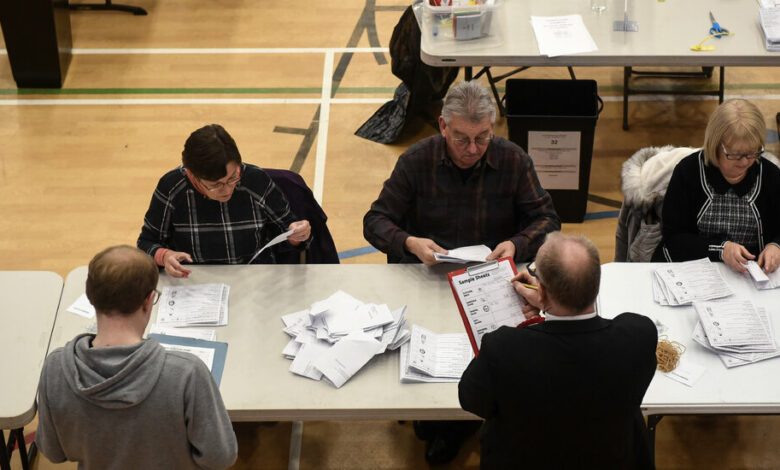What makes the British exit poll special?

When can you know who won on election night?
In Britain, there has been a remarkably good response over the past two decades just after the polls close at 10pm
That’s when three major broadcasters announce the results of the national exit poll. The work of a team of statisticians and political scientists who spring into action a few hours earlier has in recent years produced an increasingly accurate picture of the election outcome before the votes are counted.
In the last five British general elections, the exit poll predicted how many of the 650 or more seats in parliament would be claimed by the winning party, with an average of four seats. Last time, in 2019, the winning party was off by just three seats.
Below is a guide on what to expect and how it works.
Let’s start at the beginning. What is an exit poll?
It is a survey of voters shortly after they have voted. The British survey literally seeks out voters as they leave a polling station: field workers ask more than 20,000 people at around 130 polling stations across the country to fill in replica ballot papers. Since 2005, there has been one exit poll for every British general election, paid for by the three major broadcasters, the BBC, ITV and Sky.
How can the British be so accurate?
It wasn’t always like that. In the 1992 general election, the BBC exit poll predicted that no party would win an outright majority of seats in parliament, before early results quickly showed the Conservatives on course to retain power. Exit polls in previous elections have been even more off the mark.
The key change, say those involved, came in the 2000s, when broadcasters pooled their resources behind a statistical approach developed by academics David Firth and John Curtice. Its success has helped turn Professor Curtice into a star of election broadcasts.
Previous exit polls attempted to create a representative sample of polling stations at each election. The vote totals in the sample were used to predict each party’s share elsewhere.
The new style poll still seeks a representative sample, but also returns to the same polling stations whenever possible. Now, instead of focusing on totals, researchers can make direct comparisons and examine how the mood has changed.
Using statistical models, they then predict how the changes they find will manifest themselves in districts across the country, based on further analysis of the demographics and results of previous elections in each area.
According to Jouni Kuha, professor of social statistics at the London School of Economics and member of the exit poll team since 2010, the focus on the same locations is crucial.
“There’s less noise in the data when you look at the changes than when you try to estimate the stocks themselves,” he said in a telephone interview.
According to Professor Firth, not much has changed since the early 2000s review. “Even the software I wrote in 2001-2005 is still in use,” he said in an email.
What could possibly go wrong?
As with all statistical estimates, the British exit poll has a margin of error: about 20 seats.
In a neck-and-neck race, 20 seats can be a lot. In 2015, after five years in a coalition government with the centrist Liberal Democrats, the centre-right Conservatives unexpectedly won a slim parliamentary majority. That year’s poll underestimated their performance by 15 seats — within the expected margin of error, but enough to suggest wrongly that they might still need help from another party to govern.
Opinion polls suggest that the race will not be close this year. However, there is still an element of luck. There is always the possibility that the selected polling stations will not be representative.
“People think there’s magic,” Professor Curtice recently told The New York Times. “But we’re only as good as the data.”
In 2019, just before the exit poll, there were reports of a major shift in the British electoral map, Professor Firth noted: “There is nothing in the new methods that guarantees such bizarre accuracy!”
The biggest challenge is time pressure. In the UK, most people vote in person on polling day and it’s a working day, so there’s a surge of votes in the early evening. That leaves a small window before 10pm to collect and analyse the data.
The redistricting in much of the country since 2019 could also prove to be a problem this time around.
Why isn’t there an exit poll like this everywhere?
American experts are cautious about exit polls, and for good reason.
America’s main exit poll, conducted by a consortium of news organizations (mostly broadcasters) and Edison Research, attempts to achieve a broader range of goals under significantly tougher conditions.
Instead of one question on a mock ballot, voters surveyed are typically asked 20 questions that collect demographic and issue data. The results are used to help project winners, but also to create a broader analysis of why people voted the way they did on election night.
And there is a major obstacle to copying the British approach: absentee and early voting are much more common in the United States. 41 percent of the votes were cast that way in 2016 and 70 percent in 2020, compared to 21 percent in the last UK election. The US exit poll reflects this by using a telephone, email and text survey, as well as talking to voters in person.
“While our work in 2004, 2016, and 2020 has been criticized for specific errors in specific states and races, the average error in surveys is generally lower than it was decades ago,” Edison Research co-founder Joe Lenski noted in an interview from 2021 with the American Enterprise Institute. “The real problem is educating about the kind of precision you can and can’t demand of this data.”
Complaints about exit polls are even louder elsewhere. India’s general elections this year saw high stock market volatility and allegations of election fraud from the opposition after exit polls wrongly predicted a large majority for the incumbent BJP. Instead, the party was forced to form a coalition government.
What does it matter if an exit poll is really good?
Election night is usually less turbulent and some viewers in Britain will turn off the tv broadcast once the exit poll is completed.
But it can still provide some entertaining moments. During the BBC’s 2015 election broadcast, former Liberal Democrat leader Paddy Ashdown expressed his disdain for the prediction that his party would end up with just 10 seats, down from 57. “If this exit poll is accurate,” he said, “I will publicly eat my hat off to your programme.”
Ultimately, the Liberal Democrats won eight seats and the BBC handed Mr Ashdown a hat shaped cake.
For Professor Kuha and his team, key moments have already occurred in the minutes before the 10pm deadline. “It’s a very strange experience for an academic who is used to very different timescales,” he said. “So it’s a bit stressful, but also exciting.”




